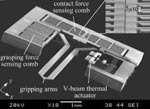 Robots at the nanoscale can already do some basic manipulation. But it remained difficult to control to enable them to perform more complex actions such as handling of nanoelectronic components or cells. To overcome this problem, a team of University of Toronto (Canada) announced having developed a pair of robotic grippers can move independently in the middle of a microscopic environment, without damaging the surrounding components. The principle is simple: these micro robots are endowed with the sense of touch. “The robots are equipped with load cells that allow them to perceive their environment through touch,” said L’Atelier Philippe Bidaud, director of the Institute for Intelligent Systems and Robotics (ISIR). “And therefore include data such as weight of an object, the resistance of a membrane,” says he.
Robots at the nanoscale can already do some basic manipulation. But it remained difficult to control to enable them to perform more complex actions such as handling of nanoelectronic components or cells. To overcome this problem, a team of University of Toronto (Canada) announced having developed a pair of robotic grippers can move independently in the middle of a microscopic environment, without damaging the surrounding components. The principle is simple: these micro robots are endowed with the sense of touch. “The robots are equipped with load cells that allow them to perceive their environment through touch,” said L’Atelier Philippe Bidaud, director of the Institute for Intelligent Systems and Robotics (ISIR). “And therefore include data such as weight of an object, the resistance of a membrane,” says he.
Reuse of robotic processes common
According to Sun Yu, project manager, they would be the first to really feel the pressure with which they are grabbing an object and can be taken into account in their operations. “We apply the concepts already used in traditional robotic, but at the nanoscale, announced the researcher. “The experiments above do not elicit such a return. The pliers broke things they took, or break themselves,” says he. Also new: they can feel the proximity of an object and either take it or avoid it to prevent any damage. So many functions that, if the clamps are connected to a computer program containing operations to follow, let them act without human intervention. In tests on animal cells, these would nanobras robotic manipulation and made a damage rate of only 15%. “Giving these nanobots sense of touch makes it possible to achieve the nano-scale manipulation of space we do can do today to the human scale, “adds Philippe Bidaud.
Build sensors premium
And numerous applications, including industrial level. Such systems would in fact assemble microelectronic devices and sensors designed to integrate health appliance or high-tech (PC, mobile phone). A process that can be achieved with conventional manufacturing techniques. Especially it should not be expensive: the clips are made from conventional silicon wafers. If they were mass produced, they may well be offered at 10 dollars fifty pairs. Another use, not least, they have the opportunity to help rebuild body tissues. Finally, recalls Philippe Bidaud, they could play a significant role in therapy. “These systems will know certain properties of cells that we are currently inaccessible,” he concludes. From a technical perspective, each “arm” is about three millimeters long. They can catch cells and components of only ten micrometers wide. This, in less than a second.
